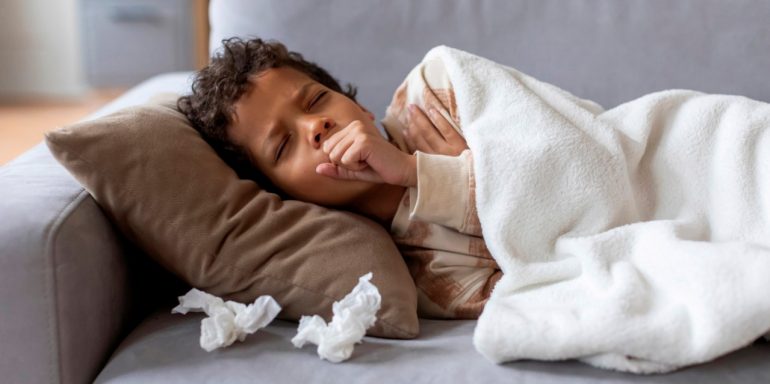
Fifth disease – signs, progression and treatment
What does fifth disease look like and how long does the rash last? How can fifth disease be treated and how long is it contagious for? Find out about fifth disease symptoms in children, teenagers and adults.
What is fifth disease?
Alongside scarlet fever, measles, chickenpox and rubella, fifth disease (slapped cheek syndrome) is amongst the typical childhood diseases that cause a rash. The illness occurs mainly in preschool and school-age children.
Fifth disease is contagious for anyone who has never had it before. Once you’ve had it, you’re immune. The virus spreads through the tiny droplets of saliva produced by coughing, sneezing and talking, as well as via hands and objects. Good hand hygiene is therefore important. As there is currently no vaccination, this is the only protective measure.
Normally, fifth disease is not dangerous for adults or children. However, people with a weakened immune system and pregnant women have an increased risk of complications and severe cases.
Note: in Switzerland, there is no obligation to report fifth disease.
Typical fifth disease symptoms
Fifth disease symptoms vary from person to person. Some can have the illness with almost no symptoms, while others notice clear signs. Characteristic symptoms include:
- Fifth disease rash: the illness causes a garland- or ring-shaped rash. It is initially visible on the face, primarily on the cheeks and forehead. It then spreads out to the legs, arms and buttocks. A rash occurs in 15 to 25% of cases. Fifth disease only sometimes causes itchiness.
- Flu-like symptoms: those affected have a fever, muscle pain and headaches and feel unwell in general.
- Anaemia: occasionally, the infection disrupts the production of red blood cells, resulting in anaemia. Signs of this include paleness, fatigue and a high pulse.
Fifth disease is often confused with other childhood illnesses such as rubella, measles or a flu-like infection, as they cause similar symptoms. Other childhood illnesses with characteristic skin rashes are:
- Measles
- Chickenpox
- Hand, foot and mouth disease
- Rubella
- Three-day fever
- Scarlet fever
The main difference between rubella and fifth disease is the pathogen: fifth disease is caused by the parvovirus B19, rubella by the rubella virus. The latter causes a rash all over the body, which starts behind the ears.
Fifth disease: progression and infection
Fifth disease has an incubation period of 4 to 14 days. This means that there can be up to two weeks between infection and the first symptoms. But fifth disease is contagious just a few days after infection. Once the skin rash occurs, the risk of infection significantly decreases. Most cases of fifth disease occur in children and teenagers between the ages of 5 and 15. By the age of 30, about 60 to 70% of people are immune to parvovirus B19 – and remain so for life.
Progression of fifth disease in children
Fifth disease usually causes mild symptoms in children that go away on their own. The typical rash occurs more frequently in children than in teenagers and adults. In the initial stages, fifth disease is similar to flu. It can lead to diarrhoea and nausea which is why fifth disease is occasionally accompanied by vomiting. In the early stages of fifth disease, the rash appears on the face – often in the shape of a butterfly around the nose. After one or two days, the rash spreads further. It disappears again after a few days. Occasionally, the rash reappears, for example due to exertion or heat. If your child is affected by the characteristic rash, their skin will require intense care over a period of four weeks.
Your child has fifth disease: how long should they stay at home? Fifth disease is especially contagious in the days before the rash occurs. So watch out for the first symptoms such as fever and fatigue and take them seriously. If you are unsure, contact your paediatrician. As soon as the rash occurs, the risk of infection is gone – if your child feels well enough, they can return to nursery, preschool or school.
Progression of fifth disease in teenagers
Teenagers do not usually get the classic fifth disease rash. Instead, fifth disease appears on the hands and feet in the form of papules and small reddish spots. In addition, the blood vessels are more clearly visible in these areas.
Progression of fifth disease in adults
Fifth disease causes more severe symptoms in adults than in children. The rash occurs less frequently. However, in many cases the joints become inflamed – especially in the ankles, knees and hands. This is why fifth disease can cause joint pain. This inflammation lasts up to three weeks. In exceptional cases, the pain persists for several months or years.
Progression of fifth disease in pregnant women
If a woman is pregnant, fifth disease progresses the same as in other adults. However, fifth disease can pose a risk to the unborn child during pregnancy – particularly in the first 20 weeks of pregnancy. An infection can lead to a miscarriage or harm the embryo.
Are you pregnant or planning to become pregnant? Talk to your doctor about your potential risk. If necessary, a blood test will show whether you have developed antibodies against parvovirus B19 and are immune.
Fifth disease: what can you do?
In most cases of fifth disease, no treatment is required as the illness is often very mild. However, if issues occur, the following measures can help:
- Fever-reducing measures: paracetamol lowers fever. Calf compresses can also help: mix 1 litre of lukewarm water with 2 tablespoons of lemon juice. Soak 2 cloths in this mixture and wring them out, then wrap the cloths around your child’s calves and place a dry cloth over them. Allow the compress to work for about 15 minutes.
- Pain-relieving measures: paracetamol relieves any joint pain or headaches.
- Skincare: nourishing creams and oil baths are very soothing for cases of fifth disease. They can help to alleviate the occasional itching caused by fifth disease. Fifth disease ointments with a high fat content are particularly effective.
How can fifth disease be prevented?
There is currently no approved vaccination against fifth disease. To prevent infection, make sure you and your child practise good hand hygiene. You do not have to keep your child at home if there are cases of fifth disease in preschool or school. This is because the illness is contagious even before the typical rash occurs. By then, your child may already be infected. Exception: if you are pregnant and not immune, it may be a good idea for your child to stay at home.
Fifth disease usually proceeds without complications. Contact your paediatrician if your child experiences severe or additional symptoms. With the right treatment, the symptoms can be alleviated quickly.

The expert provided the editorial team with expert advice and input for this article. Simeon Zürcher (PhD in Epidemiology and Biostatistics) works as a researcher in the Public Health Sciences team at Helsana.


Newsletter
Find out more about current health issues every month and get all the information you need about our attractive offers from all Helsana Group companies * delivered by e-mail to read whenever it suits you. Our newsletter is free of charge and you can sign up here:
We did not receive your information. Please try again later.
* The Helsana Group comprises Helsana Insurance Company Ltd, Helsana Supplementary Insurances Ltd and Helsana Accidents Ltd.